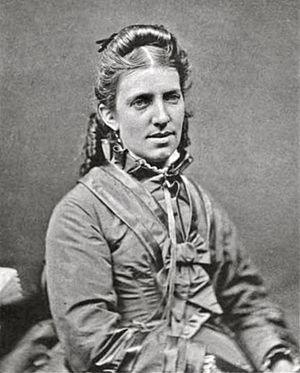Sidney Hill facts for kids
Quick facts for kids
Sidney Hill
|
|
|---|---|
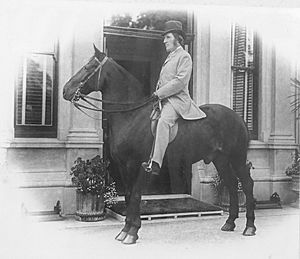
Hill riding his horse — circa 1890s
|
|
| Born |
Simon Sidney Hill
1 October 1829 Berkeley Place, Clifton, Bristol, England
|
| Died | 3 March 1908 (aged 78) Langford House, Lower Langford, North Somerset, England
|
| Occupation |
|
| Spouse(s) |
Mary Ann Bobbett
(m. 1864; died 1874) |
Simon Sidney Hill (born October 1, 1829 – died March 3, 1908) was an English businessman and generous helper of others. He started as a linen seller but became very rich trading goods from South Africa. Sidney Hill used his wealth to build homes for people in need, called almshouses, in Churchill and Lower Langford. He also built homes for Methodist church leaders in Banwell and Cheddar.
He founded Methodist churches in places like Port Elizabeth, Sandford, Shipham, and Blagdon. He also built the Wesley Methodist church and school in Churchill. Many of the helpful places he created are still around today.
Contents
Early Life
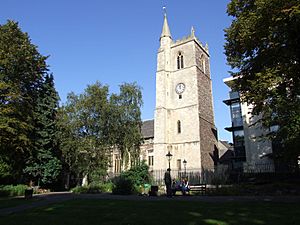
Sidney Hill was born on October 1, 1829, in Bristol, England. He was the youngest of six sons. His father, Thomas Hill, used to be a chimney sweep and soot seller. Thomas had a tough start, becoming a chimney sweep at just eight years old. He also worked for a fire insurance company.
Sidney's father died when Sidney was 17. Sidney went to a boarding school in Bath. In 1847, he joined Methodist church classes in Bristol. This is where he became a Methodist, a faith that would guide much of his life. He later dedicated a chapel to his class leader, William Bobbett.
Life as a Merchant
Starting Out

Sidney Hill was not very strong as a boy, so he didn't follow his father into the chimney sweeping business. When he turned 21, he used money he inherited from his father to open a small shop selling linen in Bristol. His business grew, and he moved to a bigger shop.
However, by 1856, his health wasn't good. His doctor told him to go to a warmer country. Sidney sold his shop and sailed towards New Zealand. But when his ship stopped at Algoa Bay in Port Elizabeth, South Africa, he decided to stay there. Soon after, he learned his mother had passed away, which made him very sad.
In 1857, Sidney opened a dry goods store in Port Elizabeth. In 1859, he teamed up with William Savage. Their company, Savage & Hill, became "Colonial and General Merchants." They traded all sorts of goods, from household items and sugar to ammunition and even ostrich feathers for fashion. Their main office was in Port Elizabeth, but they opened branches in other towns as their business grew.
Marriage and Family
In 1864, Sidney returned to London to manage the company's shipping business. On June 15, 1864, he married Mary Ann Bobbett at a Wesleyan chapel in Churchill. Mary Ann was the oldest daughter of John Winter Bobbett, a baker and flour dealer. She had gone to Quaker boarding schools and later became a housekeeper for her uncle, William Bobbett, who was also Sidney's friend and Methodist class leader.
Sidney and Mary Ann shared a strong belief in the Wesleyan Methodist Church. This faith would greatly influence their lives, especially Sidney's later charitable work.
Life in South Africa
The Hills lived in London for six months before moving back to Port Elizabeth, South Africa, in 1865. Their business, Savage & Hill, grew even more after diamonds were discovered in Griqualand West in 1870. The railway connecting Port Elizabeth to the diamond fields in Kimberley was completed in 1873. This made Port Elizabeth a very important port for trade, earning it the nickname "the Liverpool of South Africa."
Even with his busy business, Sidney found time to help the Wesleyan Methodist church in Port Elizabeth. He was a Sunday school leader and helped manage the church. In 1870, he gave £550 to help build the first Wesleyan Methodist chapel in Russell Road, Port Elizabeth.
Mary Ann's Passing
Around 1870, Mary Ann Hill became very ill with tuberculosis. Her health got worse, so the Hills left South Africa for England in April 1874. They decided to spend the winter in Bournemouth because of its mild weather. But after only five weeks, Mary Ann passed away on December 7, 1874. She was buried in Bristol. Later, in 1881, her remains were moved to the Wesleyan Methodist church in Churchill, which was built in her memory.
Later Life
Moving Back to England
After Mary Ann's death, Sidney returned to South Africa, but he couldn't settle there. In 1876, he decided to find a home near Churchill, close to his friend William Bobbett. In 1877, he bought Langford House in Lower Langford. He moved in at the end of October 1877.
Sidney retired from his business, Savage & Hill, in 1881. He had become very wealthy and used a lot of his money to improve Langford House. He changed the house, adding a tall tower in the Italianate style and decorating the inside in a typical Victorian way. In 1891, he added a clock tower above the coach house with a special clock that played tunes. He also built greenhouses to grow plants for his estate.
Farming and Animals
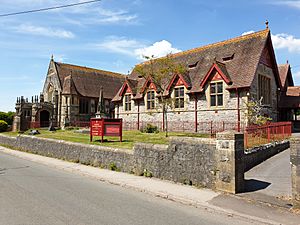
Sidney Hill started a new life as a gentleman farmer. He built stables, a dairy, and special "Bullock Palaces" for his valuable Red Scotch Shorthorn cattle. These sheds were called "palaces" because each animal had its own window and modern comforts! He was known for breeding excellent cattle, sheep, and horses.
He bought his first pedigree cows in 1881. By 1892, his herd had grown too big, so he sold them. Later, between 1897 and 1898, he bought more prize-winning cows. After his death, his entire herd was sold at an auction at Langford House.
Helping the Methodist Church
Sidney Hill did a lot to help the Methodist church in Somerset and support people in need. In memory of Mary Ann, he built the Wesley Methodist church and schoolroom in Churchill. He also set aside money to make sure the church and school could be maintained.
In 1887, he founded the Victoria Jubilee Homes, giving a farm and land to help pay for their upkeep. He also helped Methodists who moved to Cheddar for work by buying cottages and building a new church and a home for ministers. He also funded and supported twelve Wesleyan Cottage Homes in Churchill.
Other Good Deeds
Even though he was a lifelong Methodist, Sidney Hill also helped other Christian churches. He gave money to the Churchill parish church and donated £100 to build All Saints Church, Sandford. He also gave a beautiful stained glass window to Axbridge parish church after it was restored in 1887.
Sidney also helped people directly. He would find out who needed help and send them to the post office in Churchill. The post office had rooms full of household items from Langford House. The owner would give out blankets, boots, food, or whatever was needed, following Sidney's instructions. At Christmas, children from the Methodist Sunday school received new clothes. Sidney also supported the Bristol Hospital for Sick Children and Women, visiting at Christmas to give money to each patient and nurse.
Public Life
Sidney Hill was involved in many public roles. In 1885, he became a fellow of the Royal Colonial Institute. He was a Liberal in politics and became a vice-president of the Wells Liberal Association. In 1886, he became a justice of the peace for Somerset, serving on the Axbridge court for over 20 years. He was known for sometimes paying the fines for people he had sentenced, if they promised to change their ways.
He also served as president of the Weston-super-Mare and East Somerset horticultural society. He was elected to the Council of the Imperial Federation League and held important positions within the Methodist church in Bristol and Bath.
Sidney also helped his local community. He was president of the Churchill football and cricket clubs, letting them use a field on his Langford House grounds for free and helping with their finances. He also organized big celebrations for Queen Victoria's Jubilee and King Edward VII's Coronation at Langford House.
Death and Funeral
On January 26, 1908, Sidney Hill slipped and fractured his thigh at Langford House. After four weeks, it seemed to be healing, but then he got the flu, followed by pneumonia. He passed away on March 3, 1908, at the age of 78.
His funeral was held at the Wesleyan Methodist church in Churchill on March 10, 1908. Even though the weather was cold and windy, hundreds of people came from Churchill, Langford, and other villages. So many mourners attended that the service had to be held outside the chapel. Sidney Hill was buried in the same grave as his wife, Mary Ann Hill.
Legacy
Langford House was passed down through Sidney Hill's family. In 1948, the University of Bristol bought Langford House and started its School of Veterinary Science there.
Many of Sidney Hill's charitable works continue to help people today. The Victoria Jubilee Langford Homes and the Sidney Hill Churchill Wesleyan Cottage Homes are still registered charities that provide housing for local people in need.
A local historian, Ronald Henry Bailey, described Sidney Hill as "an exceptional man." He said Sidney was one of the last of the old-fashioned helpers who made life better for people before government pensions and health services existed. Sidney Hill died just as society was starting to change for the better.
While Sidney Hill became wealthy through trade, it's believed his business dealings were fair. What is certain is that he generously shared his wealth with those who were less fortunate.
Philanthropic Works
Sidney Hill did many good things for the public. He funded and supported the Queen Victoria Memorial Homes in Langford, helping people who couldn't afford good housing. He founded Wesleyan churches, Sunday schools, and homes for ministers in England and South Africa. He also gave a lot of money to help the Wesleyan church, including £500 for a chapel in Clevedon and £1,500 after his death for a mission hall in Gloucester. His last act to help the poor was to fund and furnish twelve Wesleyan cottage homes in Churchill.
| Building | Location | Type | Opened | Image |
|---|---|---|---|---|
| Wesley Methodist chapel | Russell Road, Port Elizabeth | Methodist chapel | 20 October 1872 | 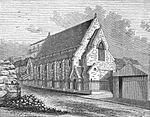 |
| This chapel in Port Elizabeth, South Africa, began building in 1870. Sidney Hill's wife, Mary Ann, laid the foundation stone. Sidney gave the land and about a fifth of the total cost for the chapel and schoolroom. The church opened in 1872. Sidney later gave a special window to the chapel in Mary Ann's memory. This building was later taken down for road work in 1969. | ||||
| Wesley Methodist Memorial church and schoolroom | Churchill | Methodist church | 2 May 1881 | 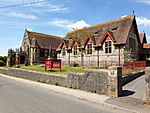 |
| Sidney Hill built this church in memory of his wife, Mary Ann Hill. He also funded a hall next to the church for community meetings. In 1898, a porch was added, also paid for by Sidney. | ||||
| Mrs Hill Memorial Cottage | Port Elizabeth | Wesleyan almshouse | January 1883 | 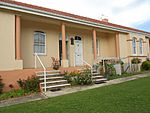 |
| At Sidney's request, and in memory of Mary Ann, the Port Elizabeth Ladies' Benevolent Society funded a small cottage. Mary Ann had been very active in helping people in need. This cottage was meant to be a free home for poor women. It had four rooms and a small garden. The cottage no longer exists. | ||||
| Dame's House | Hextable, Swanley | Orphanage | 20 July 1883 | 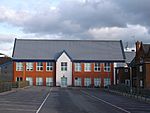 |
| Sidney Hill paid for and furnished a "dame's house" (or "mother's house") for Homes for Little Boys, which was an orphanage near Swanley, Kent. A dame's house provided a home for a staff member, usually a woman, who looked after the boys. The Prince and Princess of Wales (who later became King Edward VII and Queen Alexandra) came to open these homes. | ||||
| Victoria Jubilee Homes | Langford | Wesleyan almshouse | 1891 | 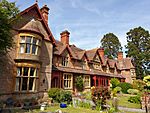 |
| To celebrate Queen Victoria's Golden Jubilee and help the poor, Sidney Hill bought land in Langford and funded six homes called the Victoria Jubilee Langford Homes. He laid the foundation stone on his 58th birthday, October 1, 1887. He also bought a farm and land to provide income for repairs and to give residents money each year for their living costs. | ||||
| Wesley Methodist chapel | Shipham | Methodist chapel | 3 April 1893 | 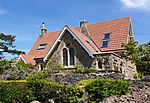 |
| This chapel was dedicated to the memory of William Bobbett, Sidney Hill's lifelong friend and Mary Ann Hill's uncle. It was built by local builders. The chapel is now a private home. | ||||
| Jubilee clock tower | Churchill | Clock tower | 20 June 1897 | 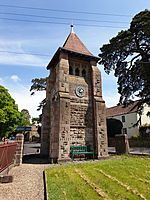 |
| This clock tower, with its chimes and drinking fountain, was built to celebrate Queen Victoria's Diamond Jubilee in 1897. The clock and chimes were fixed up in 1976, and the tower was cleaned in 1977 for Queen Elizabeth II's Silver Jubilee. | ||||
| Memorial Jubilee Wesley Methodist chapel | Cheddar | Methodist chapel | 28 September 1897 | 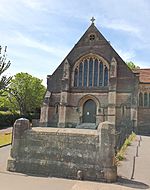 |
| Sidney Hill funded and furnished this new chapel and a home for ministers in Cheddar. The old chapel was turned into a school. A brass plate inside the church says it was built "to the glory of God by Sidney Hill... also in memory of one of the most excellent of women, for ten years the partner of his life" (referring to Mary Ann). | ||||
| Memorial Centenary Wesley Methodist chapel | Sandford | Methodist chapel | 11 October 1900 |  |
| Sidney Hill gave this chapel to the community, on the condition that the old chapel was turned into a school. It was built using local stone. | ||||
| Wesley Methodist Centenary chapel and schoolroom | Blagdon | Methodist chapel | 12 June 1907 | 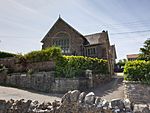 |
| This chapel was dedicated to the memory of Thomas Francis Christopher May, a lifelong friend of Sidney Hill. Sidney gave £1,500 to fund its construction. The chapel and school are now private homes. | ||||
| Sidney Hill Cottage Homes | Churchill | Wesleyan almshouse | December 1907 | 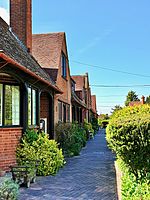
|
| These homes were built to provide comfortable, furnished places for "deserving poor" people. A fund was set up to pay for their upkeep. Twelve cottages were built around a square garden. Each house had a living room, a small kitchen area, and a bedroom. The design was inspired by a painting called "Harbour of Refuge." | ||||
| Notes | ||||
Images for kids
-
St James' Priory, Bristol, where Hill was baptised
-
Main Street in Port Elizabeth where Savage & Hill had premises
-
Wesley Methodist church in Front Street, Churchill, built in memory of Mary Ann Hill
-
Stained glass window gifted by Hill to Axbridge parish church after its restoration in 1887
See also
- Cape Colony
- Churchill, North Somerset
- Lower Langford
- Wesleyan Methodist Church (Great Britain)


